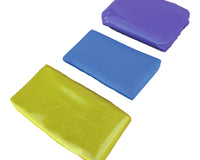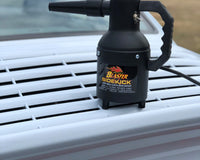Mould in your car is more than just an unsightly nuisance—it’s a health hazard and a threat to your vehicle’s interior. Whether it’s caused by damp weather, spilled drinks, or poor ventilation, mould can quickly take hold of your car’s upholstery, carpets, and even hard surfaces. Left untreated, it can cause unpleasant odours, damage your car’s interior, and even trigger allergies or respiratory issues.
In this comprehensive guide, we’ll walk you through everything you need to know about removing mould from your car and preventing it from coming back. From identifying the causes to step-by-step cleaning methods and long-term prevention strategies, this guide has you covered.
What Causes Mould in Car Interiors?
Before diving into the solutions, it’s important to understand what causes mould to grow in your car. Mould thrives in environments that are damp, dark, and poorly ventilated. Here are the most common culprits:
1. Moisture Build-Up
-
Spilled drinks or water leaks
-
Wet shoes, umbrellas, or clothing left in the car
-
Condensation from temperature changes
2. Poor Ventilation
-
Keeping windows closed for extended periods
-
Blocked air vents or a malfunctioning air conditioning system
3. Organic Material
-
Food crumbs, dirt, or dust that provide a food source for mould
-
Natural fibres in upholstery and carpets that can trap moisture
4. Environmental Factors
-
Living in a humid climate
-
Parking in damp or shaded areas
Health Risks of Mould in Your Car
Mould isn’t just a cosmetic issue—it can pose serious health risks, especially for those with allergies, asthma, or weakened immune systems. Common symptoms of mould exposure include:
-
Sneezing, coughing, and nasal congestion
-
Skin irritation or rashes
-
Eye irritation
-
Headaches and fatigue
If you or your passengers experience these symptoms, it’s crucial to address the mould problem as soon as possible.

Step-by-Step Guide to Removing Mould from Your Car
Removing mould from your car requires a systematic approach to ensure it’s completely eradicated. Here’s how to do it:
What You’ll Need
-
Rubber gloves and a face mask (to protect yourself from mould spores)
-
A vacuum cleaner with a brush attachment
-
Microfiber cloths
-
A soft-bristled brush
-
White vinegar or a commercial mould remover
-
Baking soda
-
Isopropyl alcohol (optional)
-
A spray bottle
-
A portable fan or dehumidifier (optional)
Step 1: Protect Yourself
Before you start, put on rubber gloves and a face mask to avoid inhaling mould spores or coming into direct contact with them.
Step 2: Remove Loose Debris
Use a vacuum cleaner with a brush attachment to remove loose mould spores, dirt, and debris from the seats, carpets, and floor mats. Pay special attention to crevices and hard-to-reach areas.
Step 3: Clean Hard Surfaces
For hard surfaces like the dashboard, door panels, and console:
-
Mix equal parts white vinegar and water in a spray bottle.
-
Spray the solution onto a microfiber cloth and wipe down the surfaces.
-
For stubborn mould, use a soft-bristled brush to scrub gently.
-
Wipe clean with a damp cloth and dry thoroughly.
Step 4: Treat Upholstery and Carpets
For fabric seats and carpets:
-
Sprinkle baking soda liberally over the affected areas and let it sit for 15–20 minutes to absorb moisture and odours.
-
Vacuum the baking soda away.
-
Mix one part white vinegar with two parts water in a spray bottle and lightly mist the area. Avoid oversaturating the fabric.
-
Use a soft-bristled brush to scrub the mould away.
-
Wipe with a damp cloth and allow the area to air dry completely.
Step 5: Address Lingering Odours
If the mouldy smell persists, place an open box of baking soda in your car overnight to absorb odours. Alternatively, use a car air freshener designed to neutralise odours.
Step 6: Dry the Interior Thoroughly
Mould thrives in damp environments, so it’s essential to dry your car’s interior completely. Use a portable fan or dehumidifier to speed up the drying process. If possible, park your car in a sunny, well-ventilated area with the windows slightly open.
How to Prevent Mould from Returning
Once you’ve removed the mould, the next step is to prevent it from coming back. Here are some effective strategies:
1. Keep Your Car Dry
-
Avoid leaving wet items like umbrellas, shoes, or gym clothes in your car.
-
Use waterproof floor mats to catch spills and moisture.
-
Dry your car’s interior immediately after cleaning or exposure to rain.
2. Improve Ventilation
-
Regularly open your windows to allow fresh air to circulate.
-
Use your car’s air conditioning system to reduce humidity levels.
-
Consider using a moisture-absorbing product like silica gel packets or a car dehumidifier.
3. Clean Regularly
-
Vacuum your car’s interior weekly to remove dirt and debris.
-
Wipe down surfaces with a microfiber cloth to prevent dust build-up.
-
Address spills and stains immediately to avoid creating a breeding ground for mould.
4. Use Anti-Mould Products
-
Apply a fabric protector to your upholstery and carpets to repel moisture.
-
Use a mould-inhibiting spray designed for car interiors.
5. Inspect for Leaks
-
Check for and repair any leaks in your car’s windows, sunroof, or doors.
-
Ensure your car’s drainage system is functioning properly.
When to Call a Professional
While most mould problems can be tackled at home, there are situations where professional help is necessary:
-
If the mould covers a large area or has penetrated deep into the upholstery.
-
If you’re unable to remove the mould or odour despite repeated attempts.
-
If you or your passengers experience severe allergic reactions.
Professional car detailers have the tools and expertise to thoroughly clean and sanitise your car’s interior, ensuring the mould is completely eradicated.
Conclusion: A Mould-Free Car is a Healthy Car
Mould in your car is a problem that shouldn’t be ignored. Not only does it damage your car’s interior, but it can also harm your health. By following the steps outlined in this guide, you can effectively remove mould and prevent it from returning.
Remember, prevention is key. Regular cleaning, proper ventilation, and moisture control are your best defences against mould. With a little effort and vigilance, you can keep your car’s interior fresh, clean, and mould-free for years to come.




